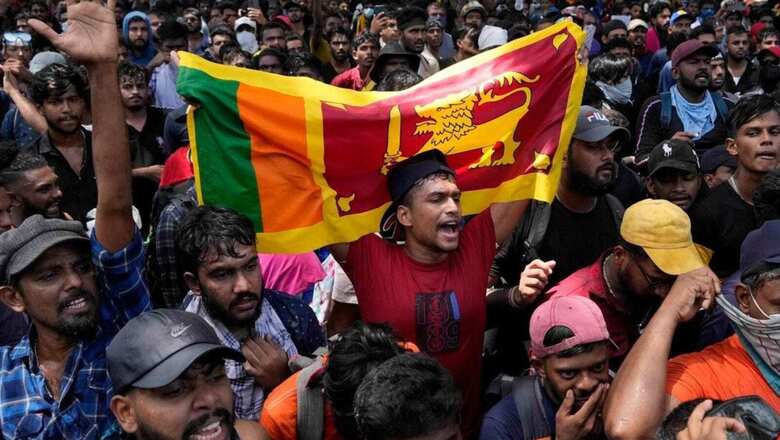
views
On Thursday, July 14, President Gotabaya Rajapaksa flew to Singapore from Maldives and emailed his resignation to the speaker of the parliament. His resignation was accepted after due authentication on Friday.
Earlier on July 9, Sri Lankan protestors had stormed into the official residence of Gotabaya Rajapaksa and the President had to be escorted out to safety by armed forces. Thereafter he was confined to some armed forces facility and tried to leave the country by a civil flight, but was blocked by immigration authorities and passengers at the terminal. He subsequently flew to Male in a military aircraft, from where he departed to Singapore.
Earlier he was denied visa to the US, as he had relinquished US citizenship in 2019 (he had been a US citizen from 2003 to 2019) to contest the presidential election. Even the Singapore authorities now want the former president to leave.
After having resisted it for three months, Gotabaya’s resignation was forced by a series of events, which started when thousands of common citizens barged into the presidential residence. The manner in which the security crumbled and the demonstrators moved into every nook and corner of the house exhibited people’s anger with President Rajapaksa and his family members who they hold responsible for the present state of Sri Lanka.
However, more shockingly, it also exhibited a complete breakdown of law and order. Even more disturbing was the fact that the mobs burnt the private residence of Prime Minister Ranil Wickremesinghe, who is in no way responsible for the crisis, but has only been trying to manage the crisis after the resignation of Mahinda Rajapaksa, President’s elder brother and former President; and refusal by Sajith Premadasa, the leader of opposition, to get into the saddle.
The President, before leaving Sri Lanka, had appointed Ranil as the interim president in accordance with the constitutional provisions. Consequently, he has been sworn in as the Interim President by the Chief Justice after Gotabaya’s resignation was accepted. Ranil had agreed to resign earlier in order to ensure the continuation of the government, safety of all citizens and to make way for an all-party government.
Earlier an all-party meeting convened by the Speaker of the parliament, Mahinda Yapa Abeywardena, had decided that both the President and the Prime Minister should leave and an all-party administration to be headed by the speaker should be set up. However, after taking over as the interim president Ranil imposed an emergency in order to establish law and order. It also needs to be appreciated that Sri Lanka at this time needs an experienced person at the helm of affairs, who can follow up on the ongoing negotiations with the IMF.
The situation in Sri Lanka has really worsened and needs mature handling and not lawlessness as was witnessed in the last few days. Having defaulted on its international obligation, food and fuel shortages have become the norm and have resulted in unending queues at fuel pumps and have forced the government to close educational institutions and implement norms for working from home.
The Army has been trying to grow food crops on barren land and government employees were being given leave to undertake farming. The inflation has already crossed 50 percent and is heading towards 70 percent. The ongoing discussions with the IMF for a potential bailout of over $3 billion, have been interrupted by the current turmoil and could be completely derailed by frequent change of government.
The Rajapaksas willingly or unwillingly have been responsible for most of the woes that have fallen on Sri Lanka. The country with the best HDI in India’s neighbourhood, and with a per capita income 50 percent higher than India, came to such penury due to flawed policies of Rajapaksa brothers after vanquishing LTTE in a decisive civil war in 2009.
The gains from the economic boom that saw Sri Lanka double its income in six years, were frittered away in pursuing extravagant infrastructural projects in the south without analysing their economic viability. Consequently, by the time the Rajapaksas were ousted in 2015, the debt had already crossed four-fifths of GDP. In 2016, IMF bailed out Sri Lanka. However, the return of the Rajapaksas in 2019, saw the economy going downhill again. Events beyond their control like Easter bombing and the Covid pandemic coupled with wrong policy decisions like lowering of tax rates and introduction of complete organic farming ruined the economy completely.
The Sri Lankan population, which has been used to a certain level of prosperity, was obviously enraged and the resultant demonstrations saw the ouster of Rajapaksas. However, it must be appreciated that the means adopted to oust them were extra-constitutional and a revolution cannot continue in perpetuity. Constitutional provisions need to be adhered to and law and order needs to be established with a firm hand.
Perpetual instability in a country, with grave ethnic and religious faultlines cannot be allowed as it can easily be exploited by external powers. For India, which has long-standing economic, security, cultural and religious linkages with Sri Lanka, any instability there could be dangerous.
Sri Lanka is a key component of New Delhi’s Indian Ocean strategy. India has accordingly been quite generous in providing financial aid and supplying essential commodities to Sri Lanka. However, Indian efforts have been stymied by the absence of a land bridge between the two countries, which would have enabled India to supply the essential commodities at a faster rate and lessen the sufferings of its citizens. A bridge with pipelines and overhead electricity pylons, could also have solved Sri Lanka’s fuel and electricity crisis.
In the long term, the country will have to tighten its belt and seek IMF assistance. The ongoing negotiations need to be clinched expeditiously and this requires a mature and experienced leader at the helm. There is no doubt the citizens will have to bear the pain for quite some time, but replacing leaders frequently is not a solution.
Sri Lanka now needs some stability, so that a roadmap can be drawn to take it out from its current economic quagmire. It is nice that the new President of Sri Lanka is going to be elected by the parliamentarians in accordance with the constitution on Wednesday; and not by the mobsters on the streets. The acting President Ranil Wickremesinghe is the front runner and is being opposed by Dullas Alahapperuma, former education minister and a member of the breakaway faction of the ruling Sri Lanka Podujana Peramuna (SLPP), and Anura Kumara Dissanayake of leftist Janatha Vimukthi Peramuna (JVP).
Hopefully, the country will have some stability, which will enable the economy to stabilise over next one year and start growing by 2024. However, as a long-term solution to prevent recurrence of such economic catastrophe, the land bridge between India and Sri Lanka needs to be constructed. This will also enhance trade and tourism and boost its economy. Sri Lanka at the moment needs both stability and better connectivity with the region to come out of its present quagmire.
Read all the Latest News, Breaking News, watch Top Videos and Live TV here.




















Comments
0 comment